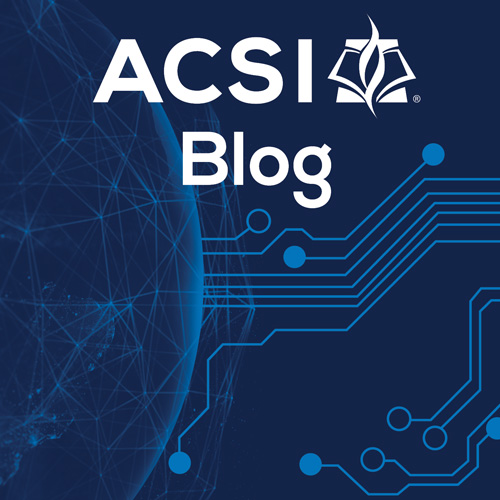ACSI Research Fellow Program
The Research Fellowship program at ACSI offers a unique opportunity for talented researchers to contribute to advancing the field of Christian education while addressing critical global challenges. By fostering collaboration, knowledge exchange, and innovative research, the program aims to make a significant impact on the world stage.
Program Aims:
- Create a vibrant and inclusive international research community.
- Foster collaboration, knowledge exchange, and innovative solutions to address both US and global challenges through research projects in Christian education.
Program Oversight:
- The fellows will collaboratively work with ACSI’s research department and Thought Leadership and the Research Director will oversee the program.
ACSI Fellows Collaborate on Research to Advance Faith-Based Education
ACSI Fellows collaborate with the Thought Leadership team (Research Department) to develop research and Working Papers on important topics in education, spirituality, and culture, focusing on their impact within the realm of Christian education. Their work addresses current trends and challenges, offering valuable insights for advancing faith-based learning.

RiB is a biannual publication by ACSI, aimed at sharing the latest research findings and insights on the Christian school sector. It is available exclusively to ACSI member school and is managed by ACSI Director of Research.

Lynn Swaner Ed.D.
President of Cardus USA – ACSI Senior Research Fellow

Matthew Lee, Ph.D.
Clinical Assistant Professor of Economics at Kennesaw State University - ACSI Senior Research Fellow

Francis Ben, Ph.D.
Associate Professor & Head of Postgraduate Coursework and Research at Tabor College Adelaide Australia – ACSI Global Research Fellow

Alison Heape Johnson
PhD candidate at the University of Arkansas – ACSI Junior Research Fellow
Eligibility:
- Understanding of Christian education.
- Strong academic credentials (e.g., relevant degrees, publications, minimum a Ph.D. candidate in education programs for Junior Fellow and a Ph.D. or Ed.D. for Senior Fellow).
- Demonstrated research excellence.
- Experience in international research collaboration.
- Excellent English communication skills.
- Minimum five years experience of doing research.
Nomination and selection process:
- The selection of the fellows is done through ACSI’s internal nomination.
ACSI Member School Enrollment: A Thought Exercise with Implications for Public Education Spending and Funding
With over 5,000 member schools (2,200 of which are U.S.-based), ACSI is the largest Protestant Christian private school membership association in the world (ECFA, 2025), serving over 650,000 K–12 students (ACSI, 2025). With a renewed emphasis on school choice, ACSI has undertaken a counterfactual thought exercise with implications for U.S. policymakers: If all ACSI students were to enroll in local or regional publicly funded schools suddenly, what would the immediate economic impact on each U.S. state look like in terms of spending and funding?
This exercise represents a one-time, immediate shock to publicly funded school enrollment for which there are no other private (sectarian or nonsectarian) alternatives to publicly funded education.
In this scenario, ACSI member schools’ students must enter the public system, causing a shift in total publicly funded enrollment. We assume the inclusion of remote enrollment, reflected at the state level. Another assumption in this scenario is that each U.S. state’s current (2025) per-pupil spending and funding allocation would remain constant, such that the influx of new enrollments affects only the total spent and funded in each state. The total amount projected for spending and funding is annualized in this exercise.
Data and Methodology
The data for our analysis comes from two primary locations.
Our state-level K–12 spending and funding data come from the Education Data Initiative (EDI) (updated February 8, 2025) and are reported across several different levels, including per-pupil spending and funding, state-level totals, and each state’s totals as a share of “taxpayer income.” Here, “spending” refers to the total amount of dollars publicly funded schools spend on students, as well as the per-pupil level (this includes common education expense categories, such as salaries, operational costs, facilities costs, transportation, etc.). At the same time, “funding” describes the dollar amount from federal, state, and local sources in aggregate (totals) and at the per-pupil level that publicly funded schools receive for each state. The dataset also reports the funding–spending gap, which is the difference between funding and spending for each state. In this exercise, the unit of analysis is U.S. states (excluding the District of Columbia), using each state’s total spending and funding, per-pupil spending and funding, and the funding–spending gap for each state. These totals represent the most recent year compiled by EDI, which sources this information directly from the United States Census Bureau and the National Center for Education Statistics (NCES), and the “share of taxpayer income” data is provided in alignment with the Bureau of Economic Analysis’ (BEA) personal-income series data.
Our ACSI member data, which is aggregated at the state level in this analysis and filtered for U.S. states and ACSI member schools (excluding higher education institutions), comes from our ACSI internal member database, housed on Protech, and was retrieved in February 2025.
State-Level High/Median/Low Impact Analyses
Highest Impact States
In Table 1, below, six U.S. states would experience a ≥ 2% increase in total education spending and funding:
| U.S. State | Impact Total Spending (%) | Impact Total Funding (%) |
|---|---|---|
| Tennessee | +5.48 | +6.30 |
| Virginia | +3.19 | +3.25 |
| Hawaii | +3.05 | +3.05 |
| North Carolina | +2.22 | +2.22 |
| Florida | +2.22 | +2.22 |
| Washington | +2.12 | +1.99 |
Among these six U.S. states, the most notable.[DH2] Based on the ACSI division and region, the Eastern Division, specifically the Southeast Region (NC, TN, VA), and Florida are significantly impacted. Western Division states are also adversely affected by the Hawaii/California Region (HI, specifically), and enrollment shifts in Washington (ACSI Northwest Region) signal comparatively high percentage impacts on spending and funding. The estimated percentage increase in state spending and funding budget, holding all else constant, is exclusively enrollment-driven in this exercise. In these six states, the impact of higher enrollment in ACSI member schools is significant enough relative to the current publicly funded student base to move total spending and funding projections upward by multiple percentage points.
- Tennessee education spending and funding would increase by 5.48% and 6.30%, respectively. These estimated impacts are roughly three to five times the state median impact. In general terms, Tennessee’s ACSI member school enrollment is comparatively high in relation to state enrollment in publicly funded institutions. This reflects an enormous hypothetical impact on district budgets, including likely strains on staffing, facilities, and transportation.
- Virginia and Hawaii spending and funding totals would increase by > 3%. In Hawaii’s single-district model, any influx from private to public schools concentrates entirely within one system, amplifying operational pressure and making percentage shifts more noticeable. Virginia’s economic impacts may be felt disproportionately, depending upon the specific regions primarily impacted by enrollment shifts.
- North Carolina and Florida estimate increases for spending and funding at just above 2%. In both states, private school alternatives are readily available and widely utilized. Regarding only ACSI member school enrollment, the impact on the public marketplace would have far-reaching implications across transportation, staffing, and facilities. Space would be a primary concern, where the use of modular and portable structures due to constraints is already heavily employed in many areas.
- Washington estimates a just over 2% increase in total spending, while the total funding impact is just under 2%. This is still enough to trigger broad-reaching resource constraint issues, especially in cities where publicly available resources are already pushed to their limit, such as qualified staffing shortages (https://www.pesb.wa.gov/current-educators/educator-shortage/).
Moderate Impact States
Just below the highest-impact states, a number of states would experience annual spending and funding increases between 1.59% and 1.95% (75th–86th percentiles). While this analysis won’t enumerate every state in detail from this point forward, two features stand out:
1. It contains a broad mix of moderate-to-high total enrollment states in ACSI’s Southeast Region systems, alongside other Western Division and Northwest Region states where ACSI’s share of enrollment in comparison with public school systems is not dominant.
2. The total funding and spending increases move in lockstep, implying that the fiscal burden appears evenly distributed between what states would spend and what taxpayers would need to raise. However, much of this depends on the distribution of enrollment by locality and region.
| U.S. State | Impact Total Spending (%) | Impact Total Funding (%) |
|---|---|---|
| Delaware | 1.95% | 1.96% |
| Alabama | 1.72% | 1.71% |
| Georgia | 1.71% | 1.71% |
| Oregon | 1.87% | 1.71% |
| Montana | 1.60% | 1.61% |
| Arizona | 1.59% | 1.59% |
| Ohio | 1.59% | 1.59% |
For policymakers, this band represents the “pay attention now” category: district leaders would likely plan for increased teacher hiring, paraprofessional support, classroom space, and transportation, but with careful planning, they could probably absorb the shift over a budget cycle or two without instituting dramatic program cuts. Operational continuity and integration plans for the short- and mid-term may make sense in this band.
Middle-Impact States
Most states (24) would be classified as having a middle impact, with estimated annual spending and funding percentage increases ranging from 0.75% to 1.56%. Across all 50 states (excluding the District of Columbia), the median estimate for the total rise in education spending is 1.11% (with funding’s median at 1.15%). Many states from the Mid-America Region are reflected in this group, along with the Southeast Region and Western Division schools, including California.
An increase in estimated spending and funding of even 1% is still a significant change for budgeting purposes. Lingering questions about temporary and flexible space, including modulars and portables, as well as access to a reliable and qualified teacher pipeline, would remain concerns, though likely not insurmountable, for this group.
Lowest Impact States
The lowest comparative spending and funding percentage increases are observed in the Northeast Region states, as well as in Utah, Wyoming, New Mexico, and other Western Division states. A likely explanation is the prevalence of different sectarian and non-sectarian private schools (predominantly Catholic schools, and in the case of Utah, Mormon-affiliated). The fact that ACSI member schools are underrepresented in these states only reinforces the need for further exploration and analysis concerning the utilization of private education alternatives to publicly funded systems and the impact that private education systems have on spending and funding.
ACSI Regional Impact at a Glance: Highest and Lowest Impacts
Southeast Region: The Southeast features heavily in the high-impact tier (TN, NC, VA, FL, AL, GA are among the top ten for increased spending percentage). Many of these states have experienced high population growth over the past decade and have active and growing private schools and faith-supportive education alternatives to publicly funded systems. A concentrated influx creates immediate pressure points in staffing and facilities, especially at the regional and local levels, even if statewide averages seem otherwise manageable.
Hawaii/Northwest Regions: Hawaii is unique among all states in this exercise because its public model exists in a single statewide district. The impact of a sudden shift in enrollment away from private alternatives would be massive. HI would likely need an emergency response plan for already strained teacher pipelines, physical plant, and classroom space. Washington and Oregon are both in the top ten (WA ≥ 2%; OR ~1.87%), with Washington in the highest impact tier and Oregon just below, which is consistent with a meaningful ACSI presence interacting with public systems that already have difficulty with qualified staffing, teacher retention, and special-education servicing.
Northeast & Mid-America: Many states in this region have lower percentage impacts, reflecting either small ACSI footprints (Northeast) or higher enrollment in non-Protestant sectarian or nonsectarian private alternatives, comparatively high current state public enrollment, or both. The operational takeaway isn’t that an influx of new students won’t impact or disrupt state or regional publicly funded education markets, but rather that the associated increase in spending and funding as a percentage of total current expenditure and funding would not be so significant an anticipated shock as to be disruptive over the mid- or long-term at the state level specifically for enrollment rollover from ACSI member schools. However, that does not provide information regarding enrollment rollover from other private schools in these states.
In all cases, it would still be highly likely that local and regional resource and capacity constraints would require coordinated action and response plans. Since most of the anticipated operational (school-level) effects would disproportionately impact dense geographic pockets (zip, city, county, or Metropolitan Statistical Areas) currently served by ACSI member Christian schools, running these economic impact analyses at the state level may disperse the risk in a way that artificially smooths the actual impact of sudden enrollment upheaval for regional and local communities.
A Note on Spending and Funding Percentages
Funding percentages closely reflect the percentage changes in spending. The highest-impact state list is where state-level decision-making, specifically scenario and contingency planning, would be prudent. Relevant stakeholders and education practitioners should consider the impact of sudden enrollment influx to publicly funded schools from the total effect on spending and funding, but also the human resource, transportation, and physical plant implications, namely the impact on teacher pipelines, transportation, education specialists, classroom space, and accommodations, and reflect somberly on the effect that ACSI member schools have on the local and regional economy and workforce.
A 2% per-pupil shift is the kind of change that, if it occurs rapidly, shows up in class size, section offerings, special-education caseloads, and auxiliary services. Systems with portable capacity (flexible space, swing staff, substitute pools) will handle the first year more effectively; everyone else will need to rely on overtime, temporary contracts, or short-term waivers. In the second year, the system pivots: FTE counts are budgeted up, capital plans accelerate, and districts normalize the higher enrollment.
The funding side is estimated to be taxpayer-borne and must move in lockstep for service levels to hold. Because these are total funding percentages, they scale with the existing cost structure: states with higher base spending will add more total dollars to hit the same percentage increase, and vice versa. That’s why percent metrics reveal the relative strain better than raw dollars.
Key Takeaways from this Counterfactual Analysis
- The median state would see a ~1.1–1.2% spending increase; the top tier experiences 2–5.5%, which is operationally significant.
- Tennessee, Virginia, and Hawaii are the highest-impact states based on percentage impact, with North Carolina, Florida, and Washington also warranting attention and proactive contingency planning.
- Funding and spending move in near lockstep, so the percentage observed on one side essentially appears on the other.
- Absolute dollar lists are dominated by very large states (and states with large ACSI enrollment); they’re helpful for budgeting but not for cross-state comparisons of stress, which is why we use percentages in our comparative analyses.
- The Southeast and parts of the West are most exposed on a percentage basis; much of the Northeast and Upper Midwest show minor effects.
- If this counterfactual were to materialize, the highest-impact states should be ready with rapid staffing, flexible/temporary space solutions, transportation contingency planning, and bridge financing for mid- and long-term planning. States with percentage changes at or below the median may be able to absorb or redirect the shift over one or two budget cycles with targeted adjustments.
| State | Spending counterfactual expenses added | Funding counterfactual expenses added |
|---|---|---|
| Tennessee | 5.48% | 6.30% |
| Virginia | 3.19% | 3.25% |
| Hawaii | 3.05% | 3.05% |
| North Carolina | 2.22% | 2.22% |
| Florida | 2.22% | 2.22% |
| Washington | 2.12% | 1.99% |
| Delaware | 1.95% | 1.96% |
| Alabama | 1.72% | 1.71% |
| Georgia | 1.71% | 1.71% |
| Oregon | 1.87% | 1.71% |
| Montana | 1.60% | 1.61% |
| Arizona | 1.59% | 1.59% |
| Ohio | 1.59% | 1.59% |
| Indiana | 1.56% | 1.56% |
| Idaho | 1.52% | 1.52% |
| Kentucky | 1.48% | 1.49% |
| Mississippi | 1.48% | 1.48% |
| California | 1.39% | 1.39% |
| Oklahoma | 1.32% | 1.32% |
| Alaska | 1.29% | 1.29% |
| Pennsylvania | 1.20% | 1.28% |
| West Virginia | 1.16% | 1.26% |
| Colorado | 1.23% | 1.23% |
| South Carolina | 1.02% | 1.16% |
| New Hampshire | 1.16% | 1.16% |
| Maryland | 1.16% | 1.15% |
| Kansas | 1.11% | 1.11% |
| South Dakota | 1.02% | 1.09% |
| Missouri | 1.01% | 1.01% |
| Nevada | 0.98% | 0.98% |
| Iowa | 0.98% | 0.98% |
| Minnesota | 0.96% | 0.96% |
| Louisiana | 0.95% | 0.95% |
| North Dakota | 0.90% | 0.90% |
| Wisconsin | 0.77% | 0.81% |
| Texas | 0.87% | 0.78% |
| Illinois | 0.75% | 0.75% |
| Arkansas | 0.74% | 0.74% |
| New Mexico | 0.65% | 0.65% |
| Nebraska | 0.62% | 0.62% |
| Vermont | 0.59% | 0.60% |
| New Jersey | 0.44% | 0.44% |
| Michigan | 0.43% | 0.43% |
| Maine | 0.42% | 0.42% |
| Massachusetts | 0.37% | 0.37% |
| Wyoming | 0.25% | 0.31% |
| Rhode Island | 0.27% | 0.27% |
| New York | 0.20% | 0.20% |
| Connecticut | 0.14% | 0.14% |
| Utah | 0.05% | 0.05% |




Leave a comment